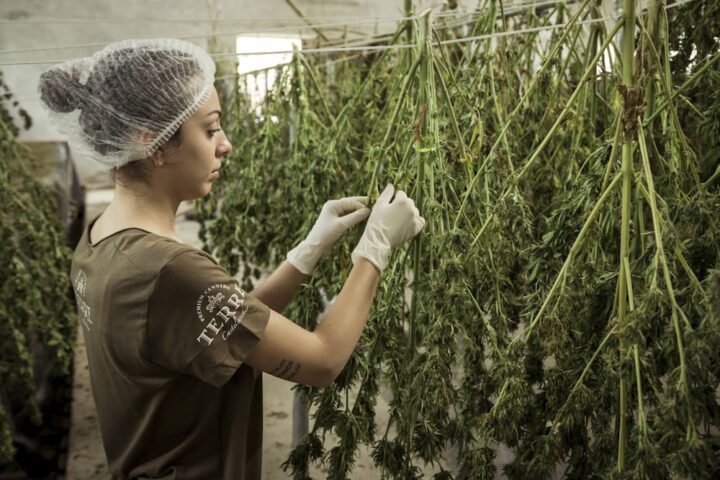Green Thumb, Greener Future: A Beginner’s Guide to Sustainable Home Cannabis Cultivation
Cannabis cultivation at home can be a rewarding endeavor, not only for the personal satisfaction it brings but also for its potential to contribute positively to the environment.
With the increasing awareness around sustainable living, incorporating eco-friendly practices into cannabis cultivation is more important than ever. This guide aims to equip beginners with the knowledge and tools needed to embark on a journey of sustainable home cannabis cultivation, ensuring that their green thumb leads to an even greener future.

Understanding the Basics of Cannabis Cultivation
Cannabis cultivation requires an understanding of the plant’s life cycle, from germination to harvest. Cannabis plants can be grown from seeds or clones, with each method having its own set of benefits.
Seeds ensure genetic diversity and vigor, while clones offer a quicker start and a genetic replica of the parent plant. The cannabis life cycle is divided into two main stages: the vegetative stage, where the plant focuses on growth, and the flowering stage, where it develops buds.
- Soil Health: Start with high-quality, organic soil rich in nutrients. The soil is the foundation of your plant’s health, and maintaining its quality without chemical fertilizers is key. Compost and natural soil amendments can enhance soil fertility and structure, promoting healthy root development and plant growth.
- Water Conservation: Cannabis plants require consistent watering, but overwatering can lead to root rot and other issues. Implementing a water-efficient irrigation system, such as drip irrigation, can significantly reduce water usage. Collecting rainwater is another sustainable practice that conserves water and provides your plants with a natural and chemical-free water source.
Selecting the Right Strain
Choosing the right cannabis strain is crucial for successful cultivation. Consider the climate of your growing area and select well-suited strains to those conditions. Auto-flowering strains can be particularly beneficial for beginners, as they transition from the vegetative stage to the flowering stage based on age rather than changes in the light cycle, making them easier to manage.
- Indigenous Strains: Opting for indigenous strains to your region can reduce the need for environmental control adjustments, such as additional lighting or heating, thereby saving energy.
- Resistance to Pests and Diseases: Selecting strains that are naturally resistant to pests and diseases can minimize the need for chemical pesticides and fungicides, further contributing to the sustainability of your cultivation efforts.
Exploring reputable seed banks that prioritize environmental responsibility can be invaluable for those interested in diving deeper into sustainable strain selection. One such resource is this comprehensive review of Homegrown Cannabis Co by the Sacramento Bee, known for their commitment to sustainable cannabis cultivation.
Sustainable Lighting Solutions
Lighting is a critical component of indoor cannabis cultivation, but it can also be one of the most energy-intensive. LED (Light Emitting Diode) grow lights offer a sustainable alternative to traditional HID (High-Intensity Discharge) lights. LEDs are more energy-efficient, produce less heat, and have a longer lifespan, reducing both energy consumption and waste.
- Natural Light: Whenever possible, utilize natural light by strategically placing your plants near windows or in a greenhouse. This can significantly reduce the reliance on artificial lighting, decreasing energy use.
- Timers and Automation: Implementing timers and automation systems for your grow lights can ensure they are only on when needed, preventing unnecessary energy use and optimizing plant growth.
Organic Pest Management
Pest management is an essential aspect of cannabis cultivation, but it doesn’t have to involve harmful chemicals. Organic pest management strategies prioritize the plant’s health, the environment, and the consumer.
Introducing beneficial insects like ladybugs and lacewings can naturally control pest populations. Additionally, homemade organic sprays, made from ingredients like neem oil and soap, can effectively deter pests without the negative environmental impact of synthetic pesticides.
- Companion Planting: Growing certain plants alongside your cannabis can naturally repel pests. For example, marigolds can deter nematodes, while basil can repel thrips and flies. This method reduces pest issues and enhances your garden’s biodiversity.
- Crop Rotation: Practicing crop rotation can prevent the buildup of soil-borne pests and diseases. By changing the location of your cannabis plants each season, you can disrupt the life cycle of pests and reduce your reliance on pesticides.
Water Efficiency and Recycling
Water efficiency is paramount in sustainable cannabis cultivation. Over-watering is a common mistake that can lead to resource wastage and plant health issues. Using a moisture meter can help you determine when your plants actually need water, preventing overuse. Additionally, setting up a system to collect and reuse runoff water can reduce water consumption and ensure no nutrient-rich water goes to waste.
- Mulching: Applying a layer of organic mulch around your plants can help retain soil moisture, reduce water evaporation, and suppress weed growth. This not only conserves water but also reduces the need for manual weeding.
- Rainwater Harvesting: Collecting rainwater for irrigation is an excellent way to reduce your water footprint. This method provides your plants with soft, untreated water, which can be better for plant growth than chlorinated tap water.
Conclusion
Sustainable home cannabis cultivation is not just about producing your supply; it’s about doing so in a way that respects and preserves the environment.
By understanding the basics of cannabis growth, selecting the right strains, utilizing sustainable lighting solutions, implementing organic pest management practices, and focusing on water efficiency and recycling, you can ensure that your cultivation efforts are as green as possible.
Remember, every small step towards sustainability has a larger impact on our planet’s health. Embarking on this journey not only makes you a cultivator of cannabis but also a custodian of the earth.


